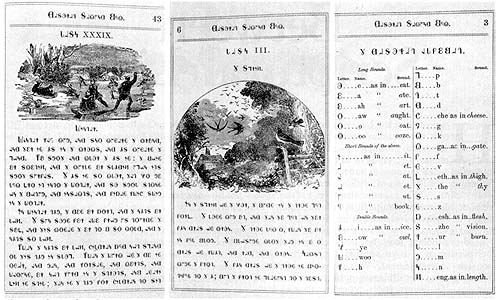“Can You Read Deseret?” Ensign, Mar. 1978, 60–61
Can You Read Deseret?
This pioneering Mormon alphabet was more than an educational experiment.
“How do you spell ‘through’?” your child asks.
“T-H-R-O-U-G-H,” you tell her.
And then she comes home from school with a C on her paper. One of the mistakes you find is this sentence: “John through the ball through the window.”
Patiently you explain to her that when you mean threw you spell it differently from through. And just as patiently she says, “That’s silly. Why should you spell it two different ways when it sounds the same?”
Good question! And in pioneer Utah, with new converts pouring in from many European nations, the early Latter-day Saint leaders decided something had to be done about the English spelling system.
On 19 January 1854, the Deseret News carried an official announcement that explained that the “Board of Regents [of the University of Deseret], in company with the Governor and heads of departments, have adopted a new Alphabet, consisting of 38 characters.” At first, the board of regents had hoped to simply revise English spelling using the existing alphabet. But no amount of juggling, it seemed, could reach their goal: one letter for every sound, and only one sound for every letter.
So an alphabet, largely devised by George D. Watt, a convert who had studied an earlier phonetic alphabet in England, was adopted by the Territory of Utah. “These characters are much more simple in their structure than the usual alphabetical characters; every superfluous mark supposable, is wholly excluded from them,” said the Deseret News article. But to those used to standard English writing, the Deseret Alphabet looks as if it should be held up to a mirror to be read!
Spelling reform in the English language was not a new idea. Noah Webster, the creator of America’s pivotal dictionary, simplified some English spellings, changing colour to color, for instance; yet although his changes were adopted in the United States, they never spread back to Great Britain. Other reformers, such as English playwright George Bernard Shaw, have clamored for changes in English spelling.
How did English spelling get like it is? The reason is basically that English, as a hodge-podge of Anglo-Saxon, Norman French, and smatterings of Gaelic, Danish, and other languages, has become a hopeless mixture of different types of spelling. Actually, though, English spelling was following a natural tendency to straighten itself out as people began to spell things the way they sounded until the great English lexicographer, Samuel Johnson, wrote his definitive dictionary of the English language. Some spelling changes have come since then, of course, but by and large Dr. Johnson froze English spellings the way they were in the eighteenth century—and even went so far as to make many English spellings more difficult by adding silent letters to show the word’s origin. For instance, det was given an extra b, becoming debt, to show its supposed origin in the word debit.
The Deseret Alphabet was one of the earliest—and in some opinions, one of the best—full-scale efforts to make English spelling sensible. The designers of the alphabet broke down English speech into six long vowels, six short vowels, one aspirate (h sound), and twenty-one articulate sounds (consonants). One professor of linguistics has commented, “The designers of the Deseret Alphabet made a correct phonemic analysis of English on the whole. They were more successful in breaking down the antiquated traditional orthography than many more recent reformers who have attempted to respell English.” (J. M. Cowan, “The Deseret Alphabet,” paper presented to Linguistic Society of America, 27 July 1940.)
And the Latter-day Saint spelling reformers were serious—they meant the alphabet to be used. Two elementary readers were produced in 1868; after all, one of the purposes of the Deseret Alphabet was to enable children to learn to spell more easily. Articles also appeared in the Deseret News printed in the new alphabet, and the entire Book of Mormon appeared in the Deseret Alphabet in 1869.

Two lessons from Deseret Second Book; key to the alphabet.
The alphabet was also adopted by a good number of individuals. Many pioneer diaries and records were written in the new orthography, and because of the shortened spelling—the word through, for instance, has only three letters in the Deseret Alphabet—many clerks used it for taking down speeches. For fifteen years the alphabet was sporadically used—but the alphabet was impractical for use unless the rest of the English-speaking world adopted it, and the majority of the Saints found it too difficult to learn, or too boring to the eye of the reader. Other more pressing issues and problems took precedence and the alphabet faded from use around 1870.
The Deseret Alphabet, strange as it seems today, was right in keeping with the pioneer spirit. The Latter-day Saints in Utah Territory were trying to build something new—a new society, a new economy, a new system of governing—and a new alphabet went right along with that reforming mood. As Elder John A. Widtsoe of the Council of the Twelve said: “The Deseret Alphabet represents a noble experiment with a thoroughly worthwhile objective. Mormons have reason to be proud of this episode in the history of their people.” (Gospel Interpretations, Bookcraft, 1934, p. 265.)